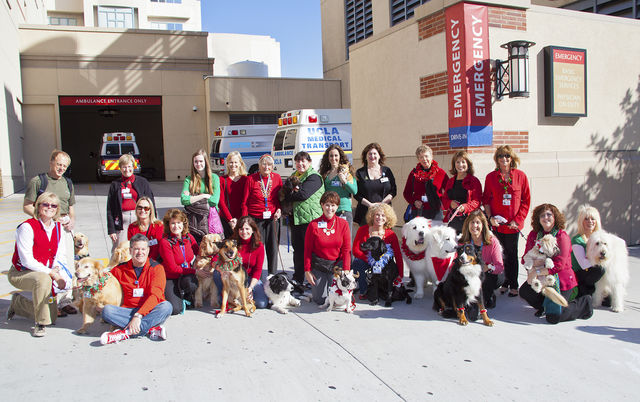Animal-assisted therapy group supports students, UCLA Health patients and staff

UCLA Health’s People-Animal Connection program began when a cardiology nurse noticed patients who had fish tanks in their rooms did better during medical treatment. It connects therapy dogs, and one therapy miniature horse, to students and UCLA Health patients. (Courtesy of UCLA People-Animal Connection)
By Maya McNealis
July 1, 2019 10:45 a.m.
Erin Rice once watched her therapy dog make a 6-year-old boy open his eyes, look at his mother and begin communicating after a surgery that removed one hemisphere of his brain.
“’This warm, fuzzy thing in his bed, this is what’s going to help him create those connections in his remaining hemisphere,’” Rice said a neurologist told her. “I changed my career for this kind of moment.”
Rice is the director of UCLA People-Animal Connection, a volunteer-run organization that connects trained dogs, and one miniature horse named Blue Moon, to students on campus and to patients and staff at UCLA Health centers.
PAC, founded in 1994, was one of the first animal-assisted therapy groups in the country and has been used as a model both nationally and internationally, Rice said.
“We get calls all the time from different hospitals and internationally on how to implement similar programs,” she said.
All PAC volunteers are vetted by Rice and her team. The dogs must be registered as therapy dogs and complete training and a six-to-eight-week orientation and probation period. The dogs and volunteers can only go out on visits twice a month.
Training therapy dogs includes obedience training, as well as training to help them acclimate to the hospital environment, said Jane Tomlinson, who has volunteered with PAC for 19 years.
Volunteers go through training as well, she added.
“You’re considered a team member,” Tomlinson said. “You’re evaluated as much as your dog.”
Rice said PAC currently has 75 teams of volunteers and dogs and is hoping to add another 25 teams in order to meet patient demand. In addition to bimonthly hospital visits, PAC participated in 80 special events this year at UCLA, she added.
The program hosts reoccurring events on campus such as UCLA Library’s Stressbusters program, in which PAC teams spend time with students in Powell Library during finals week. Last year, PAC dogs and volunteers also attended a UCLA basketball game, the UCLA Athletics Health and Wellness Fair, Nurses Week and Capus Health Mental Awareness Week.
Tomlinson has volunteered at UCLA with her dog Bubbles for the past five years, bringing the black Labrador retriever to events such as Powell Library Stressbusters and Alumni Day, she said. She added they also visit offices around campus to bring cheer to students and faculty.
“We love working with the students,” she said. “Every time I leave, they just can’t thank you enough.”
PAC also brings its volunteer teams to visit patients at Ronald Reagan UCLA Medical Center and Santa Monica UCLA Medical Center.
Mark Morocco, a UCLA emergency medicine physician who helps coordinate PAC visits to the emergency department, said the PAC program was founded by a cardiology nurse who noticed patients who had aquariums in their rooms had better outcomes following treatment.
He added there is significant statistical evidence supporting animal-assisted therapy.
“They did a study not long after the program was up and running,” he said. “Patients with visits from pet-assisted therapy had lower levels of adrenaline compounds, lower blood pressure and lower heart rates.”
Morocco said the dogs have a profound impact on the mentalities of both patients and hospital staff.
“A visit from a dog breaks the illusion of the hospital,” he said. “It makes the hospital feel less like a sterile, weird place. Modern hospitals, including ours, look kind of like a spaceship inside, and so PAC allows the patients to feel their humanity and these dogs have an effect that lasts for a couple of days.”
Another PAC program, “No One Dies Alone,” brings more specialized volunteer teams to the bedsides of patients judged to be entering the last 72 hours of their life.
“We have about 12 to 15 PAC teams that are additionally trained for these specialized visits as they’re more intense … we prepare for a lot of the deeper things that might come up, like feelings of their own mortality or feelings about a loved one that has passed,” Rice said.
She said that with the rise in opioid addiction rates, health professionals around the country and world have been searching for alternatives to prescription painkillers to provide patients pain relief, including programs such as PAC.
Therapy dogs work, Tomlinson said, because they provide nonjudgmental comfort and love.
“Many times I’ve gone to the room where the patient is depressed or they don’t want to move and the nurses can’t get them up,” she said. “And then here comes a dog, and sits on the bed, and before you know it – the warmth, the touch, the dogs don’t ask them questions, it’s unconditional love.”


